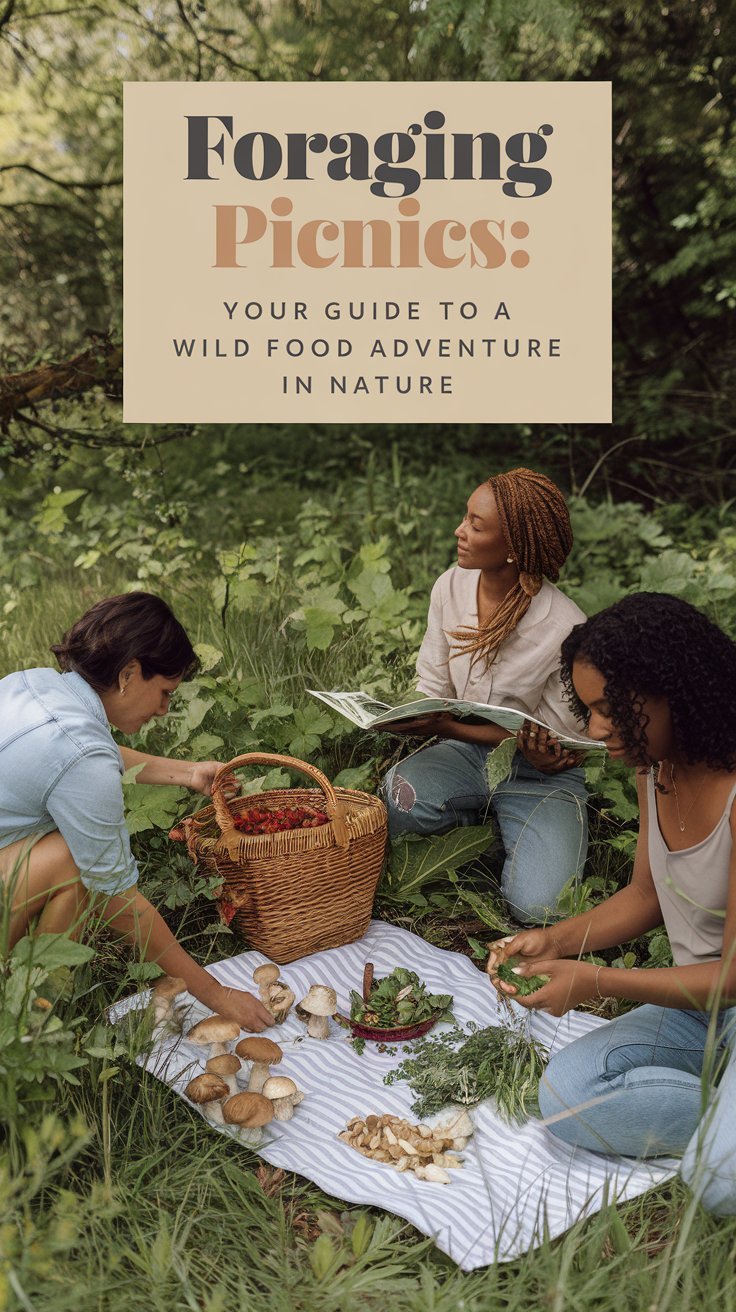There’s something deeply satisfying about connecting with nature in its most fundamental way—through food. A foraging picnic combines the thrill of the hunt with the pleasures of outdoor dining, creating an experience that’s educational, delicious, and wonderfully memorable.
Whether you’re an experienced forager or a curious beginner, gathering edible treasures from the wild and enjoying them in a beautiful setting offers a unique way to celebrate our connection to the earth.
Let’s explore how to create a safe, enjoyable foraging picnic that will have you seeing your local parks and wild spaces through new, more delicious eyes!
Planning Your Wild Food Adventure
A successful foraging picnic starts with thoughtful preparation and knowledge.
Safety First: Foraging Fundamentals
Before you begin, commit to these essential principles:
- Positive Identification: Never consume anything unless you’re 100% certain of identification
- Sustainable Harvesting: Take only what you need, leaving plenty to regrow
- Legal Considerations: Research where foraging is permitted in your area
- Toxic Lookalikes: Learn about dangerous plants that resemble edible ones
- Start Simple: Begin with easily identifiable, common edibles like blackberries
- Multiple Sources: Confirm identifications with at least three reliable references
- Expert Guidance: Consider joining a guided foraging tour for your first experience
“My number one rule is ‘when in doubt, leave it out,'” emphasizes Elena, an experienced foraging instructor. “No matter how excited you are to try something new, if you’re not absolutely certain of identification, simply enjoy observing it instead of eating it. There will always be more foraging opportunities, but mistakes can be dangerous.”
Seasonal Awareness
Understanding what’s available when:
- Spring: Tender greens, shoots, flowers, and wild onions
- Early Summer: Berries begin, edible flowers peak, young nuts
- Late Summer: Prime berry season, mushrooms begin, wild fruits
- Fall: Nuts, late mushrooms, persistent berries, roots
- Winter: Limited options—focus on evergreen tips, certain roots, and bark teas
Location Selection
Finding the perfect foraging and dining spots:
- Public Lands: Check regulations—many parks prohibit collection
- Private Property: Always get permission from landowners
- Pollution Considerations: Avoid roadsides, industrial areas, and places with pesticide use
- Abundant Growth: Look for healthy ecosystems with diverse plant life
- Water Sources: Many edibles grow near streams, ponds, or wetlands
- Edge Habitats: Transitions between woods and fields often have diverse offerings
- Elevation Changes: Different plants thrive at different heights
- Return Visits: Develop relationship with specific locations through seasons
“I keep a foraging journal with maps, seasonal notes, and photos,” shares Maya, who hosts monthly wild food gatherings. “We revisit the same locations throughout the year to witness the changing offerings. It’s amazing how a single meadow transforms from spring greens to summer berries to fall nuts. This knowledge makes each foraging picnic more successful than the last.”
Essential Foraging Equipment
The right tools make your wild food adventure safer and more productive.
Harvesting Tools
- Folding pocket knife or foraging knife
- Small scissors or pruners for clean cuts
- Collection baskets (breathable, ideally with a flat bottom)
- Paper or cloth bags for different types of finds
- Gloves for thorny or irritating plants
- Digging stick or small trowel for roots
- Separate containers for delicate items
Identification Aids
- Region-specific field guides (physical books are more reliable than apps)
- Magnifying glass for examining details
- Small notebook for recording findings
- Camera for documentation
- Plant identification apps as backup reference
Practical Additions
- First aid kit with tweezers and antiseptic
- Hand sanitizer or biodegradable soap
- Water for cleaning hands and finds
- Sturdy shoes and weather-appropriate clothing
- Walking stick for checking undergrowth
- Insect repellent (natural options preferred)
- Sun protection (hat, sunscreen, sunglasses)
“Organization is key when foraging,” advises Jordan, who teaches wilderness skills. “I bring different containers for different types of finds. Delicate mushrooms get their own ventilated box, berries go in shallow containers so they don’t crush, and greens go in cloth bags where they can breathe but won’t wilt. This system not only protects your harvest but helps keep similar-looking plants separate until you can verify them at home.”
Beginner-Friendly Foraging Finds
Start your wild food journey with these easily identifiable edibles.
Wild Berries
- Blackberries: Thorny canes, distinctive compound berries
- Raspberries: Similar to blackberries but fruit separates from core when picked
- Mulberries: Tree-growing berries resembling elongated blackberries
- Elderberries: Clusters of small dark berries (note: must be cooked before eating)
- Wild Strawberries: Tiny, intensely flavored versions of cultivated strawberries
Leafy Greens
- Dandelion: Familiar yellow flowers with toothed leaves
- Chickweed: Small white flowers, paired leaves, forms mats
- Lamb’s Quarters: Dusty blue-green leaves that shed water
- Violet Leaves: Heart-shaped leaves with edible flowers
- Plantain: Parallel-veined leaves in rosettes (not related to the banana-like fruit)
Flavorful Additions
- Wild Garlic/Ramps: Distinct garlic/onion smell when bruised
- Wild Mint: Aromatic square stems, paired leaves
- Pine Needles: From known pine trees for tea
- Spruce Tips: Bright green new growth in spring
- Wild Roses: Petals and later rose hips
“When I introduce newbies to foraging, we always start with berries,” shares Priya, who organizes community nature walks. “They’re familiar, easy to identify, delicious raw, and offer immediate gratification. After building confidence with berries, we move to distinctive greens like dandelion and mint. This progressive approach builds both skills and confidence while minimizing any risk of misidentification.”
Crafting Your Foraging Picnic Menu
Combine wild-harvested treasures with brought-from-home staples for a memorable meal.
Basic Framework
- Base Elements: Bring bread, crackers, pasta, or grains as foundation
- Protein Sources: Pack cheese, nuts, hard-boiled eggs, or cured meats
- Wild Additions: Foraged items add flavor, color, and nutrition
- Simple Preparations: Focus on recipes that highlight natural flavors
- Backup Plan: Ensure you have enough brought food in case foraging is limited
Wild Food Preparation Ideas
- Foraged Salad: Wild greens with conventional dressing
- Infused Water: Fresh berries or herbs in drinking water
- Wild Teas: Pine needles, mint, or flower petals steeped in hot water
- Flower Garnishes: Edible blossoms atop conventional foods
- Berry Desserts: Wild fruits with brought chocolate or pastry
- Wild Pesto: Blend foraged greens with olive oil, nuts, and cheese
- Stuffed Wild Greens: Fill large leaves with premade fillings
“I like to think of foraging as finding special seasonings for my picnic, rather than trying to gather an entire meal,” explains Taylor, who writes about wild food. “I bring good bread, cheese, and a simple olive oil, then use our foraged finds to create unique flavor combinations. A crusty baguette tastes even more amazing when spread with fresh cheese and topped with just-picked wood sorrel or wild garlic. The wild elements transform simple ingredients into something extraordinary.”
Foraging Picnic Activities
Enhance your wild food adventure with these engaging activities.
Educational Elements
- Plant Identification Challenges: Friendly competitions to correctly identify finds
- Taste Tests: Compare similar plants or different parts of the same plant
- Nature Journaling: Record observations, locations, and tasting notes
- Sensory Exploration: Observe plants using all senses (carefully!)
- Traditional Uses Research: Learn how different cultures used local plants
- Seasonal Mapping: Note what’s growing where for future visits
Creative Pursuits
- Botanical Sketching: Draw your finds before consuming
- Natural Dyeing: Create fabric impressions using plant materials
- Wild Food Photography: Document your discoveries and creations
- Cordage Making: Learn to twist plant fibers into string
- Flower Pressing: Preserve specimens in portable press books
- Nature Mandalas: Create beautiful arrangements of found materials
Knowledge Building
- Field Guide Comparisons: Compare how different books describe the same plant
- Storytelling: Share folklore and stories about various plants
- Habitat Analysis: Discuss why certain plants grow together
- Ethical Harvesting Discussions: Talk about sustainable practices
- Medicine vs. Food: Learn about plants with both culinary and medicinal uses
“Our foraging picnics always include what we call ‘plant speed dating,'” laughs Sofia, who teaches ethnobotany. “Everyone gets two minutes with different plants to sketch them, note key identification features, and observe details before moving to the next one. It’s fun but also trains you to notice distinguishing characteristics quickly. We end by comparing notes and discussing what we observed, which dramatically improves everyone’s identification skills.”
Seasonal Foraging Picnic Themes
Adapt your wild food adventures to nature’s changing offerings throughout the year.
Spring Awakening Picnic
- Focus: Tender greens, shoots, flowers
- Activities: Identifying first spring plants, monitoring growth
- Menu Highlights: Wild green salads, flower-infused water, spring onion flatbreads
- Location Tips: Sunny forest edges, meadows with southern exposure
- Equipment: Scissors, shallow baskets for delicate greens
Summer Abundance Picnic
- Focus: Berries, fruits, flowers at their peak
- Activities: Berry collection competitions, flower preservation
- Menu Highlights: Fresh berries with cream, flower cordials, stuffed grape leaves
- Location Tips: Sunny berry patches, meadows in full bloom
- Equipment: Multiple containers for different berries, sun protection
Fall Harvest Picnic
- Focus: Nuts, seeds, late fruits, mushrooms
- Activities: Mushroom identification, nut gathering
- Menu Highlights: Roasted nuts, mushroom sandwiches, autumn fruit compotes
- Location Tips: Mature forests, old orchards, mixed woodlands
- Equipment: Sturdy bags for nuts, specialized knife for mushrooms
Winter Discovery Picnic
- Focus: Evergreens, persistent berries, roots
- Activities: Winter plant identification, tracking
- Menu Highlights: Pine needle tea, root vegetables, preserved finds from other seasons
- Location Tips: Conifer forests, sheltered valleys with winter sun
- Equipment: Thermos for hot drinks, digging tools for roots, extra warmth layers
“Winter foraging picnics are actually my favorite,” shares Olivia, who forages year-round. “There’s something magical about finding food when everything seems dormant. We bring a camping stove to make hot pine needle tea on the spot, which is so warming and rich in vitamin C. We also dig certain roots like burdock, which reach their peak flavor after the first frost. The quiet winter landscape makes the experience feel especially intimate and connected to nature’s cycles.”
Sustainable and Ethical Practices
Ensure your foraging adventures help rather than harm the natural environment.
Responsible Harvesting Guidelines
- Take only 1/3 of any patch, leaving 2/3 to reproduce
- Cut or pinch rather than pulling roots when appropriate
- Leave the healthiest specimens to propagate
- Harvest from abundant populations only
- Avoid rare or declining species entirely
- Rotate harvesting locations to prevent overuse
- Consider cultivating popular wild edibles at home
Minimizing Environmental Impact
- Stay on established trails when possible
- Tread lightly in sensitive environments
- Pack out all trash (including fruit pits and peels)
- Use biodegradable soap if cleaning finds on site
- Avoid introducing non-native species
- Report unusual environmental concerns to local authorities
- Leave no trace of your picnic or harvesting
Respecting Other Species
- Check plants for wildlife before harvesting
- Leave food sources important to local animals
- Observe rather than disturb wildlife encountered
- Consider animal habitats before setting up picnic
- Share your abundance with nature by leaving some behind
“Ethical foraging means always taking less than you think you could,” emphasizes Aisha, an environmental educator. “I teach my students to approach wild harvesting with gratitude and restraint. We carefully assess each plant community before taking anything, asking if it’s abundant enough to harvest from, if there are animals that depend on it, and if we’re really going to use what we take. This thoughtful approach ensures we’re participating in nature’s cycles rather than exploiting them.”
Preserving Your Wild Harvests
Extend the joy of your foraging picnic by preserving excess finds.
Simple Field Techniques
- Proper storage in breathable containers during your picnic
- Quick vinegar rinses for certain greens to maintain freshness
- Layering delicate items with damp cloth
- Keeping mushrooms separate and well-ventilated
- Immediate processing of fragile items like berries
- Creating simple syrups or infusions on-site with portable stove
At-Home Preservation Methods
- Drying: Herbs, flowers, mushrooms, berries
- Freezing: Most berries, prepared greens, mushrooms
- Tinctures: Medicinal plants in alcohol or glycerin
- Vinegars: Flavored with herbs and flowers
- Oils: Infused with aromatic finds (use caution regarding botulism risk)
- Fermentation: Wild vegetables, fruits, or greens
- Jams and Jellies: Wild fruits and some flowers
Documentation for Future Reference
- Create detailed notes on locations, seasons, and uses
- Photograph plants in their habitat before harvesting
- Record successful recipes and preservation methods
- Note changes in populations year to year
- Share knowledge respectfully with like-minded enthusiasts
“I love extending our foraging picnics through preservation,” shares Rafael, who teaches traditional food skills. “We often bring a small camp stove and make simple berry syrups right on location, while the fruits are at their peak freshness. The rest we carefully transport home for freezing or jam-making. Our pantry becomes a time capsule of our adventures, with each jar and dried bundle holding memories of special days in nature.”
More Creative Picnic Inspirations
Looking for more themed picnic ideas? Here’s a collection of creative concepts to try throughout the year!
| Creative Picnic Ideas | Unique Picnic Concepts | Themed Picnic Experiences |
|---|---|---|
| Zodiac Picnic | Global Street Food Picnic | Dessert-Only Picnic |
| Literary Picnic | Farm-to-Blanket Picnic | Childhood Favorites Picnic |
| Monochromatic Picnic | Wild Cocktail Picnic | Photography Picnic |
| Historical Era Picnic | Science Picnic | Mindfulness Picnic |
| Movie Night Picnic | Music Festival Picnic | Sports Viewing Picnic |
| Mocktail Picnic | Sandwich Tour Picnic | Ice Cream Social Picnic |
| Full Moon Picnic | Plant-Based Power Picnic | Vintage Tea Party Picnic |
Conclusion: Wild Food, Rich Connections
A foraging picnic offers so much more than just a meal—it provides a profound way to connect with our environment, our food sources, and each other. By learning to see the landscape through the lens of edible possibilities, we develop a deeper relationship with nature and tap into ancient human knowledge that’s increasingly rare in our modern world.
The combination of careful harvesting, knowledgeable identification, creative preparation, and outdoor enjoyment creates an experience that engages all the senses and creates lasting memories. Whether you’re discovering the intense flavor of a tiny wild strawberry, the refreshing zing of wild mint tea, or the earthy richness of freshly harvested mushrooms, these direct experiences with wild food bring a satisfaction that store-bought ingredients rarely match.
As you develop your foraging skills and knowledge, remember that the journey itself—the slow, observant walks, the excitement of discovery, the careful harvesting, and the shared enjoyment—is as nourishing as the food you find. A successful foraging picnic isn’t measured by quantity harvested but by the quality of connection experienced—with nature, with ancient food traditions, and with those sharing the adventure.
Happy foraging, friends!
































